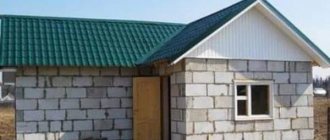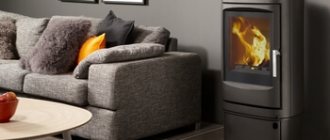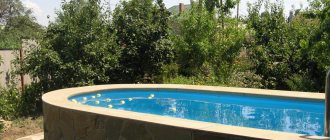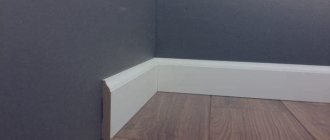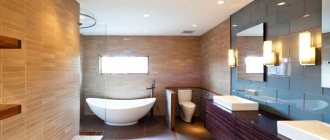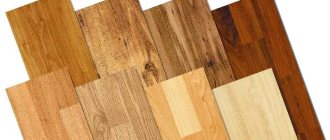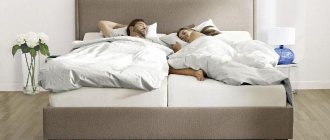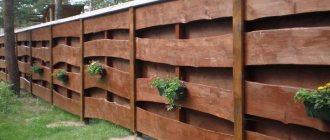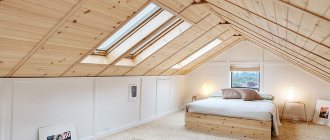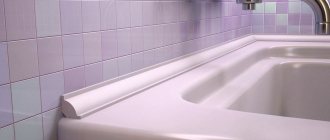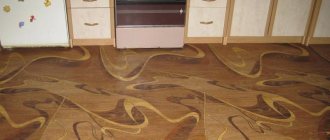What influences construction?
Materials for building a house must be selected in advance and very carefully. There are no perfect building blocks. All of them have both advantages and relative disadvantages. The choice should be made so that the “cons” are compensated.
Construction is directly affected by external conditions. Houses are built in different climatic conditions and soil characteristics.
Houses made from building blocks are built faster than conventional ones. Quality may vary depending on several factors:
- The course of groundwater,
- Type of foundation and its stability,
- Required construction speed,
- Complexity of exterior decoration, etc.
First of all, you need to decide whether the house will have a basement or a basement. If groundwater is too close, expensive foundation waterproofing and drainage may be required.
Before construction begins, the type of foundation is determined. Some types of blocks do not tolerate movement. This affects the stability of the foundation. The cost will increase if the walls need to be erected in an extremely short time.
Please note that not all building blocks can withstand getting wet. They must be protected from precipitation during the construction process. Walls can be vapor-tight. You can make thermal insulation, which will reduce heating costs.
Without the listed nuances, it is impossible to begin full-fledged construction. All these points need to be discussed in advance.
Technical parameters of blocks for building a house
When choosing a material for building a house, the first place is not aesthetics, but reliability and durability. And before deciding which blocks are best to build a house from , you should pay attention to the following parameters:
- thermal conductivity coefficient of the material, and the lower the indicator, the thinner the walls can be;
- strength, namely the ability of the block to withstand compressive loads;
- frost resistance, indicated in the number of defrosting/freezing cycles, reducing the strength of the material by 10%. Using this indicator, it is possible to determine the service life of the structure, taking into account the characteristics of the climatic zone;
- volumetric weight, defined as the weight of 1 m3, depends on the density of the block product and is taken into account when calculating the foundation;
- heat capacity, that is, the ability of walls to accumulate heat;
- moisture resistance and hygroscopicity of the material;
- vapor permeability, which determines the microclimate in the room;
- fire and fire resistance;
- noise and sound insulation qualities;
- dimensions of products, as well as the presence of additional elements;
- environmental friendliness and safety for human health, some blocks are produced using raw materials that pose a certain threat and are strictly prohibited for residential construction.
Of course, when choosing a material, its cost plays a significant role, as well as the speed and features of constructing the box at home. The functional purpose of the object and the features of its operation (seasonal or year-round) must also be taken into account.
What is the best material to build a house from? Video:
Types of building blocks
Creating rooms from building blocks does not require much time. Brick construction takes much longer.
The building blocks are:
- Lightweight concrete sections,
- Foam concrete,
- Expanded clay block,
- Aerated concrete,
- Polystyrene concrete,
- cinder block,
- Porous ceramics or ceramic block,
- Pressed cement-sand blocks.
Aerated concrete blocks: pros and cons
Aerated concrete is a cement-sand mixture that contains dry foam-forming reagents. When water is added, the reagents react with the laitance and foam begins to form. The material increases in volume, the solution is laid out in special forms and is expected to be completely ready.
Aerated concrete is a material consisting of thin concrete shells with air inside. The blocks are warm and light, they do not let in steam and moisture. When building with aerated concrete blocks, you should not delay waterproofing the foundation and finishing.
A standard aerated concrete block is 600 mm long, 200 mm high, and 150 to 400 mm wide. Weight varies slightly depending on the manufacturer. When producing blocks of this type, one of two technologies can be used.
First technology: the solution is put into molds and then used. The second technology: large blocks are made and cut into small ones. The principle of the second technology is that it is possible to achieve maximum accuracy. You can use special glue rather than masonry mortar made of sand and cement. It is laid in a thin layer of a few millimeters. Thanks to thin, neat seams, heat loss is reduced. But glue is an expensive product, so the total cost of construction increases. At the same time, there are savings on insulation.
Advantages of aerated concrete:
- Ease of processing,
- Achieving the required dimensions,
- Vapor conductivity,
- Fire resistance
- Environmental Safety,
- Ability to work with a hacksaw.
Disadvantages of aerated concrete:
- The high cost of glue, which increases the cost of construction,
- The need for reinforcement
- Requires exterior finishing and foundation waterproofing,
- Intolerance to bending loads,
- Cannot be installed in areas with seismic activity.
Aerated concrete is easy to work with; it can be cut with a saw or created grooves using a metal strip. The material is not too dense, so you should not hang heavy objects on the walls without special fasteners.
Let's note some shortcomings. Aerated concrete blocks are quite fragile; they do not withstand bending loads very well. It is better not to make a house from aerated concrete blocks on a columnar or pile foundation. You can use deep tape or slabs.
Another feature: to increase the strength of the walls, you need to lay steel reinforcement in the third or fourth row. Reinforcement of window and door openings is also necessary. The armored belt is also used for roof installation. All these procedures make construction more expensive. Costs for fittings are included in the estimate without fail.
Production of foam concrete and aerated concrete blocks
In composition, these two materials differ little from each other, but in the production method they differ significantly. If a foaming agent is used to form cellular pores with a closed structure for foam concrete, then aerated concrete blocks are obtained as a result of a chemical reaction, thanks to aluminum paste (or powder). As a result of the reaction occurring between the catalyst and lime, a porous structure of the product is formed, which has an open shape.
The production of aerated concrete is carried out in two ways: autoclave and non-autoclave, with a natural process of drying the products.
Foam concrete is of non-autoclave origin. Externally, one material can be distinguished from another by color; foam concrete blocks have a grayish tint, and aerated concrete is bright snow-white.
Blocks can be made in two ways:
- pouring the prepared solution into molds of the appropriate size;
- manufacturing a monolith with subsequent cutting of blocks.
Foam concrete, after entering the aerated concrete market, began to lose its position to the latter. One of the main problems of foam concrete products can be considered quite noticeable shrinkage of the material, especially those that have passed through the drying chamber, and high hygroscopicity. In addition, foam concrete is noticeably inferior in terms of thermal insulation characteristics.
About foam concrete blocks, video:
Main characteristics of aerated concrete
The method of manufacturing aerated concrete blocks affects its properties, so the material made by the autoclave method has greater strength, and therefore load-bearing capacity, and products produced by the conventional method have a lower thermal conductivity coefficient.
When choosing aerated concrete blocks, you should definitely pay attention to such a parameter as density, which can be obtained from special alphanumeric markings, for example, D400, D500 or D700 indicates the weight of 1 m3 of the product, but not only, since this indicator is more informative and indicates the scope of use: for load-bearing walls or partitions.
That is, the higher the density, the higher the strength, but also the higher the thermal conductivity coefficient. Aerated blocks with density indicators from D400 to D700 have the optimal combination of all indicators.
Sometimes, especially when building houses for year-round use in a climate zone with harsh winters, the box is built from two layers of material, one of them with a lower density but higher thermal insulation qualities.
If you pay attention to reviews from home owners , you will notice that an attractive point is the possibility of using not only traditional products with standard dimensions, for example, 625x300x250 mm (although blocks with other parameters are available on the market), but also the use of special blocks for lintels, as well as for the installation of floors.
In addition, for partitions it is recommended to use products with a smaller width, which can significantly save usable space.
Features of the construction of houses made of aerated concrete and foam concrete blocks
You can build a house from these materials in the shortest possible time, including with your own hands. This is facilitated by the rather large size of the products and the accuracy of their linear dimensions. You can lay foam blocks and aerated concrete either using regular mortar or using special adhesive compositions.
Until now, therefore, even experts are arguing, citing as arguments, first of all, the cost of one and the second type.
But one thing is obvious: the use of an adhesive composition is more justified, since with this option the thickness of the seams has minimal values, which means that heat loss will also be minimized. And besides this, when building a house from blocks using adhesive mortar, it is easier to adjust the construction at the horizontal and vertical levels, especially considering their almost ideal linear shapes.
Despite the fact that foam concrete and aerated concrete are two different materials, they have common pros and cons , of which you should pay attention to the following:
- sufficiently high vapor permeability of the walls, ensuring the creation of a microclimate in the room favorable for humans;
- satisfactory indicators of thermal conductivity and heat capacity;
- sufficient load-bearing capacity allowing the construction of buildings up to 12-15 m in height;
- fire resistance;
- environmental safety, as they are made from natural raw materials;
- durability, on average the service life of a house made of foam concrete is 40-50 years, and buildings made of aerated concrete – up to 80 years;
- frost resistance is 25-50 cycles, while autoclaved aerated concrete exceeds this period and has indicators equal to 50-100 cycles.
If we consider the “cons”, then, first of all, you should pay attention to:
- the hygroscopicity of these materials, while for aerated concrete the ability to absorb moisture depends on the density: the higher this indicator, the higher the moisture resistance. In order to eliminate this drawback, it is necessary to complete the facade finishing as soon as possible, and it is absolutely undesirable to leave the house “without clothes” for the winter;
- the presence of cold bridges, which significantly reduce the thermal insulation qualities. And if the use of an adhesive composition instead of a traditional solution can eliminate this disadvantage, then the presence of reinforcing belts requires a radical solution, first of all, the installation of an additional heat-insulating layer.
Read more about building a house from aerated concrete here.
What types of gas blocks are there?
Blocks of this type can be conventional or autoclave cured. To build external walls, it is optimal to choose autoclave blocks, since their characteristics are more stable. Their cost is more expensive than usual.
Often, a certain amount of cement in aerated concrete is replaced with another material, for example, silicate concrete is made from lime and cement, and slag-gas concrete is made from ground blast furnace slag and cement. Cement with lime and ash creates a material such as ash concrete.
If we talk about the construction of houses with permanent residence, then it is best to use silicate concrete blocks. The material differs from standard aerated concrete in its color. Aerated concrete is gray in color, while silicate concrete is white. The addition of lime reduces the cost with a slight deterioration in properties. But it is worth remembering that lime will corrode steel over time.
↑ Types and characteristics of building blocks
Using building blocks you can build a house much faster. The parameters of the building material allow masonry to be carried out at an accelerated pace. It is also much easier for builders to work, because the block has a small mass. Before you start choosing material for your home, you need to consider the following points:
- The course of groundwater. A lot depends on the depth at which they lie: the foundation, the basement, the material of the walls, the construction of the basement, the ground floor. If groundwater is close to the surface, you will have to take care of waterproofing pads and drainage. And this work will need to be carried out either at the beginning or simultaneously with the construction of the foundation.
- Since the blocks are installed on a foundation, it is important to know what type of foundation it will be and how stable and stable it will be.
- Important points include the time frame for building a house, for example, whether the construction time is two months or a year and a half.
- It is important to decide at the very beginning of construction whether the box will remain unroofed for the winter or whether a roof is planned before the onset of frost. Some building materials cannot be left without a roof in cold, snow and rain.
- External cladding. This is important when choosing building materials, since not all blocks can survive the winter without covering. Some will have to be covered from snow and rain due to getting wet.
- It is important to decide whether your walls will be vapor-permeable or have high thermal insulation qualities.
Before you decide on the choice of product for building walls, you need to answer each question. Without considering these points, there is no point in choosing blocks, since each type has its own technical characteristics and purpose.
Depending on the size, blocks for construction are divided into large-sized and small-sized. Small-sized products have small dimensions, low thermal conductivity and strength. Blocks from the large-size group have high strength, their sound and heat insulation rates are average, and their sizes are large. Another classification is based on the category of material from which the blocks are made. The basis for creating any type of block is concrete. All other components are additional ingredients and technological processes.
Therefore, depending on the secondary materials used, groups were identified.
↑ Groups of lightweight concrete blocks:
- expanded clay;
- ceramic blocks;
- aerated concrete;
- cinder blocks;
- foam concrete;
- gas silicate;
- polystyrene concrete;
- wood concrete;
- press blocks made of cement and sand (heat blocks, solid and empty inside).
When deciding what material to build your house from, you first need to understand how they differ from each other, and also carefully study the technical qualities of each group of blocks. The following characteristics need to be considered: parameters, frost resistance, material density, compressive strength, heat conductivity. Knowing the characteristics of each group of building blocks, you can calculate how much material will be needed to build a house.
These characteristics will also help you decide on the choice of product. After all, the choice depends on the type of work, for example, it will be a load-bearing wall or an internal partition, the construction of a summer shower or the construction of a two-story garage, etc.
And if a house is being built, then several groups of building blocks can be used.
Foam blocks for the construction of residential buildings
Foam blocks only at first glance resemble aerated concrete. The difference is that ready-made foam is added to the mixture of sand and concrete, rather than a dry type reagent. The mixture is kneaded, placed in molds and left to dry. Foam concrete can be made in almost any conditions. But nothing can be said about the stability of the characteristics. However, the material itself is quite good.
Foam concrete has some of the best thermal characteristics. They are only slightly inferior to aerated concrete. Foam concrete walls are usually thicker. But at the same time the load on the foundation is greater. This means that the dimensions of the foundation and the costs for it increase. There is no definite answer which will be cheaper: using gas blocks or foam blocks.
Aerated concrete has lower thermal conductivity, this is explained by the fact that the walls of the air bubbles are thicker. Aerated concrete is more durable and practical. It should be noted that foam block walls allow screws to be screwed in. Special fasteners hold just perfectly.
Gas blocks
These are briquettes made from aerated concrete, a material from the cellular concrete family. It consists of the same materials as traditional concrete:
- Portland cement;
- sand;
- lime;
- water.
The fundamental difference of this material is the porous structure that arises as a result of the chemical reaction of the working solution with a gas-forming agent - aluminum paste. It is added after mixing the base components. A reaction begins with the release of gas, during which the material is placed in molds and kept for a certain time. Aerated concrete rises like yeast dough, acquiring its porous structure. When the reaction is complete, the raw material is cut into blocks and sent to an autoclave for 12 hours, where they are treated with hot steam under pressure.
Advantages of aerated concrete:
- light weight, no excess load on the foundation;
- low heat transfer coefficient, allowing you to save thermal energy;
- smooth and precise shape of the blocks, allowing you to make thin seams (2-4 mm);
- high laying speed, the work can be performed by unqualified builders.
Minuses:
- high hygroscopicity, walls must be protected with moisture-impermeable sheathing;
- low strength, there is a restriction on the height of buildings (up to 3 floors);
- the material does not withstand bending loads (multidirectional loads), as well as pressure.
These properties differ significantly from the parameters of traditional concrete, which caused a wave of criticism from builders. Many people try to approach new material with old, familiar standards. However, subject to technological requirements and construction rules, aerated concrete allows you to save on heating and reduce costs during the construction of the foundation.
Pros and cons of foam blocks
Foam blocks are durable, but they have a low density. But, since it is quite simple to produce foam blocks, there is a risk of purchasing low-quality handicraft material.
Thermal insulation properties are high. However, the material cannot withstand long-term bending load. It is necessary to create a strong, stable foundation. The characteristics are not uniform because the pore sizes are different. The block has a rough surface, ensuring good adhesion to plaster mixtures. The choice of finish requires a special approach. The material is environmentally friendly.
Large weight for the material is a minus. Due to the large space, an increase in the size of the foundation is required. It is also necessary to attract helpers. But, if we compare a foam block wall and a brick wall, the thickness of the latter will be greater. In any case, foam block is an economical material. It should also be noted that foam blocks are not a very aesthetic material. After construction, exterior finishing is required.
The important advantages of the material include:
- Environmental Safety,
- Non-flammability,
- Good sound insulation.
The material conducts steam, but less than aerated concrete. At the same time, the frost resistance of foam blocks is higher. Foam concrete does not have ideal geometry. The difference in size can be quite large. The masonry is done only with mortar; the seam must be made thicker to compensate for the size difference between the blocks.
Foam blocks can be easily drilled, cut, and grooved with conventional tools. You can use a grinder or even a hand saw. This feature of the material simplifies plumbing and finishing work. Installation of electrical wiring in such a house requires a minimum of time.
In general, we can say that foam block is an inexpensive material that will last for many years if you make the right choice of manufacturer. Walls made of foam blocks are erected very quickly. The house is quiet, warm, you can use self-tapping screws. It is not advisable to leave a box without a roof over the winter. Finishing is required, which can be done some time after the walls are erected.
Foam blocks can be used to build load-bearing walls in buildings up to three floors. In this case, a brand from D900 and higher is used. It is important to check in advance what kind of cement the manufacturer uses in foam blocks. Check certificates and brand strength in advance.
What else influences the choice of wall blocks for external walls?
There are a number of requirements that building blocks must meet:
- thermal conductivity, support of load-bearing capacity during the life of the building, the use of warm blocks for building a house;
- resistance to different temperatures, the material must withstand dozens of freezing and defrosting cycles. Different types of blocks for construction can withstand 25-35 cycles;
- density. The pressure of the wall on the foundation and the weight of the foundation depend on it; on average, the density of the block for load-bearing walls should be at least 800 kg/m3;
- moisture absorption. A small number of materials have this function, so it is especially necessary;
- performing a decorative function, it is important to emphasize the advantageous aspects of the appearance of the building according to the design idea.
It is necessary to take into account that each type of block has its pros and cons.
House structures are divided into two types:
- Homogeneous. Blocks are used to build a house from one material. Most often for the construction of brick, stone or wooden buildings. They have the property of retaining heat.
- Combined. They consist of several types of blocks for building a house, each of which performs its own function.
Polystyrene concrete blocks
Polystyrene concrete is cement with the addition of polystyrene granules. This improves stackability. The mixture is stirred, water is added and poured into molds. You need to wait until it cools completely. This technology does not imply achieving ideal geometry, however, the material is easy to process.
Polystyrene concrete blocks can be sawed with a regular hand saw. The shape is stable and durable, shrinkage is minimal. The material has a small mass. It is smaller compared to aerated concrete of similar strength.
Polystyrene concrete blocks are quite large, construction proceeds quickly. The material is placed on a regular solution; it is allowed to use glue. It is applied in a thin layer, but adhesives are more expensive. The negative side is standard for lightweight concrete blocks. To increase strength, reinforcement is needed. A number of companies place reinforcement inside the blocks.
The material can also be used to create load-bearing walls. You can purchase lintels for installation above door and window openings. They have fittings inside. Solidity is ensured, the jumpers act as corners.
Building blocks - what are they?
Modern blocks for construction are made in the shape of a rectangular parallelepiped. The dimensions of the elements are much larger than standard bricks.
Types of blocks for construction differ in a number of parameters:
- dimensions;
- designs;
- the type of filler used;
- purpose;
- manufacturing technologies;
- masonry features;
- technical parameters.
When choosing blocks, you should focus on the specific purpose of the building or structure being constructed.
Advantages of most types of blocks for construction compared to bricks:
- minimum construction period;
- reduction in labor requirements;
- reduced loads on the base;
- improved thermal insulation properties;
- no need for finishing coating.
Positive and negative properties of polystyrene concrete blocks
Let us note the undeniable advantages of this type of material:
- Density, lightness, strength,
- No labor-intensive processing required
- High construction speed,
- Block size,
- Does not support combustion
- Low level of moisture absorption,
- Good sound insulation and thermal conductivity,
- Vapor permeability similar to wood,
- Frost resistance.
Let's note some disadvantages:
- Blocks need to be reinforced, which makes production more expensive and longer,
- Exterior finishing required
- The technology has disadvantages, the characteristics depend on compliance with a number of rules,
- Fasteners are needed if you need to fix objects on the walls,
- There is an artificial component.
Polystyrene concrete has an average level of vapor permeability. The characteristics are similar to those of wood. There is good thermal conductivity.
It is important to note that a structure made from blocks of this type requires cladding. There are not technical, but aesthetic reasons for this. But you can survive several winters without cladding, since frost resistance is at a good level.
When choosing a cladding, you can choose the popular option – the ventilated façade. If you don’t want to use a ventilated façade, you can use plaster, but the usual mixture will not adhere well to cement. The plaster must have polymer additives in its composition. Its consumption is very small, and the walls turn out beautiful and smooth. You don't have to use rough plaster. First, the mesh is stuffed, and then decorative plaster is applied. It is difficult to say how reliable this plaster is, but, nevertheless, it is quite in demand.
Polystyrene blocks are the best choice if you want to build a house at an affordable price and in a short time. However, there is one “but” - you should not have a negative attitude towards polystyrene and you should not be afraid of the need to think about fixing to the walls. It is better to consult with a specialist on how to install doors and windows with polystyrene blocks.
Types of building blocks
The main competition for brick, a traditional material loved by many private developers, comes from blocks, for the production of which cement, clay or lime are used as binders. Sand, expanded clay, slag, sawdust, perlite, rock chips, and other materials can be used as fillers.
Thus, the blocks differ from each other not only in composition, but also in structure, and, accordingly, in operational characteristics, allowing their use at several stages of construction, starting with the construction of the foundation and the construction of the walls of the house box, and ending with partitions and ceilings.
Foundation blocks for the strip foundation of a house
FBS blocks , for the production of which heavy concrete grades are used, are an excellent material for constructing a reliable strip-type foundation for a house. Most often, a monolithic slab is used as a “pillow” for them or a monolithic tape is poured.
In the event that an underground level device is planned, then they are a serious alternative to a conventional strip foundation, outperforming it both in terms of labor costs and speed of construction, as well as in cost.
To increase the strength of the material, reinforcement is used in production, which allows the use of reinforced concrete blocks for the construction of high-rise buildings.
In addition to FBS, FBV (products with a cutout) are also used for foundations, which are convenient for laying underground communications and FBP (hollow), which are used in cases where the weight of the future structure is light or for the construction of load-bearing walls, and have increased thermal insulation qualities.
Using concrete blocks for the foundation , most likely, you will have to use the services of special equipment, since due to their sufficient weight, their installation is problematic, unless, of course, you use blocks with dimensions of 20×20×40 cm and a weight not exceeding 35 kg.
But regardless of what blocks were used for the foundation , this method of its construction provides obvious advantages, including:
- possibility of year-round performance of work;
- reduction of construction time, since there is no need to wait for the concrete to mature;
- the beginning of the construction of the box coincides with the completion of the foundation work;
- possibility of use on almost any soil, except heaving;
- reduction in the volume of work and operations, since there is no need for formwork, reinforcement and concrete pouring.
When building a foundation from FBS blocks , you should definitely pay attention to such indicators of the product as frost resistance and compressive strength. In addition, hygroscopicity should be taken into account, as well as the brand of cement used for their manufacture.
Cellular types of blocks for building houses
This type of material combines three types of products: aerated concrete, foam concrete and gas silicate blocks, which are widely used in low-rise construction.
Often among non-specialists, confusion arises both with the names of materials and with their differences from each other. Sometimes, they are generally perceived as the same product, but with different names. But this is not so and there are fundamental differences between them.
Expanded clay concrete blocks
Blocks of this type are a well-known and popular material for construction. A mixture of cement and sand is not all the components of the material. Expanded clay is also added, after which everything is mixed and water is added at the final stage. Expanded clay concrete blocks are created using proven standard technology, however, they have their own characteristics. Expanded clay is called baked clay; this material is hygroscopic. To ensure the mass meets the requirements, add more water.
Expanded clay requires a longer mixing of the solution. In production conditions, the problem of the required level of strength can be solved. For example, the solution is processed in an autoclave or vibrocompression is used. If such treatments are not carried out, the material has lower strength properties. The technology for creating blocks is quite simple, so the material is often created in artisanal conditions that do not stand up to criticism. The place of production can be garages and other outbuildings that are not intended for this purpose at all. The blocks are simply made from molds and dried quickly. Note that to achieve strength, expanded clay concrete needs at least 28 days. A separate place is required to store the material. Many “manufacturers” do not know this and immediately sell the created material. Due to the lack of “ripening”, it quickly crumbles and becomes deformed.
Factory material has all the certificates and is more expensive. If you need blocks for the construction of a residential building, you should ask the manufacturer if he has permits. It is dangerous to use handicraft material.
The best ceramic blocks
The material in question is made of molded clay with further annealing at elevated temperature parameters, which adds reliability. They are used during the laying of walls and fences. This form of products makes it possible to erect a structure in the shortest possible time, and have a look that is similar to brickwork, but with greater productivity.
Braer 38
It is considered the best block in the segment under consideration for quick methods of constructing buildings due to its dimensions of 38x25x21.9 cm, multi-floor structure, which contributes to low weight and increased strength of installation of the material in a row. Alternating the parameters of the cells will ensure a chaotic position of the partitions inside and evenly distribute the load. The outer walls are equipped with ribs that provide high adhesion to other finishing materials.
Pros:
- Large blocks are comfortable to lift due to the presence of multiple protrusions;
- m100 makes it possible to use them for the construction of a multi-story building;
- low heat conductivity makes it possible to save energy resources;
- comfortable weight during construction;
- There are 60 pieces on a pallet;
- small holes will prevent the solution from getting deep into the voids;
- in a car with a carrying capacity of 20 tons it is possible to transport up to 1100 units;
- the void content will be 60%, which does not create a load on the base with thick walls;
- the material does not draw water inside due to its low water absorption of 11%;
- There is no chamfer, which makes it possible to control the uniformity of the seams.
Minuses:
- overcharge;
- further finishing will be required due to effective frost resistance.
Pros and cons of expanded clay concrete blocks
The undeniable advantages of blocks of this type include:
- Big sizes,
- Light weight,
- Excellent thermal insulation properties compared to brick.
Solid expanded clay concrete has a lower thermal conductivity than the materials mentioned above. At the same time, expanded clay concrete is much stronger. You can create slotted blocks with it. To build external walls, only expanded clay concrete is used. Thermal insulation is impeccable at all stages of operation of the building. The material has some voids, which reduce its weight and prevent the foundation from being too large and bulky.
Expanded clay concrete walls do not require additional reinforcement. The laying is done quickly and without any problems. The blocks can withstand bending loads very well. There are no too stringent requirements for the foundation. Buildings made from such blocks allow the presence of a columnar or pile foundation.
Expanded clay concrete has some disadvantages. The main thing is high water absorption. In this respect the material is similar to aerated concrete. It is not advisable to do exterior finishing right away. The box should not stand for a long time without a roof. This way it will pick up moisture, and the lifespan of the building will be reduced. It is impossible to achieve perfect geometry, but cement-based plaster can be used. This material fits well and holds securely.
Advantages of expanded clay concrete:
- Light weight but good level of strength,
- Fire resistance
- Simplicity and accessibility of technology,
- Use of natural ingredients,
- Frost resistance is at an average level for the vibration-pressed version, and at a high level for the autoclave version,
- Excellent adhesion to cement-based plaster compositions,
- Good thermal properties.
Disadvantages of the material:
- There are chances of purchasing a low-quality product,
- There are dimensional deviations,
- Low degree of thermal insulation
- External finishing and protection of internal walls from vapors is required.
If you use slotted expanded clay concrete blocks, you will need external insulation. The material is hygroscopic and is not recommended for use as partitions in spaces with high humidity. To build a steam room or make a bathroom partition, it is better to use a different material. To avoid dampness in private housing construction, a vapor barrier can be installed. Humidity control is carried out, including thanks to a high-quality ventilation system.
Before cellular concrete appeared, expanded clay concrete was considered the warmest and lightest material for the construction of residential buildings. Now this material is somewhat inferior to other, more modern materials. It is gradually being forced out of the market by aerated concrete and foam concrete.
Expanded clay concrete blocks are highly environmentally friendly. Only water, cement, sand and expanded clay are used. No artificial ingredients are used. There are also no surfactants, that is, surfactants, which are found in aerated blocks.
Gas silicate blocks
This is another representative of cellular concrete, which is an exclusively structural material for construction, but with high thermal insulation properties. It is produced exclusively using the autoclave method from the same types of raw materials as aerated concrete, but with a slight difference.
The mass fraction of lime in gas silicate is much larger and is its main component (along with Portland cement). And in the production of gas blocks, it, together with aluminum powder, acts as a catalyst for a chemical reaction.
It is precisely because of this feature that people sometimes take up arms against this material, considering it hazardous to health, but, as research shows, this is far from the case.
It has a significantly higher load-bearing capacity than aerated concrete, which allows it to be used to construct buildings up to 20 m in height (up to 5 floors). But at the same time, the building blocks of this material have low bending abilities, which requires the construction of a reliable foundation, preferably in the form of a monolithic slab, although other options are allowed, depending on the number of floors of the building and the total weight of the building.
The main advantage of gas silicate is often called its lower cost, even compared to other cellular concrete.
Considering that the standard dimensions are 600×200×300 mm, it is sometimes acceptable, especially in middle or southern latitudes, to build external walls in one row, but for climate zones with fairly cold and long winters this is still not enough.
And since the material, due to its high hygroscopicity, requires finishing, it is often combined with the installation of a thermal insulation layer, preferably with slab insulation made of mineral wool.
Expanded polystyrene is also quite acceptable, but its use will worsen the vapor permeability of the walls and in this case it will be necessary to take care of additional forced ventilation in the house. Therefore, given this feature of the material, the most common type of finishing for gas silicate blocks , as well as for aerated concrete and foam concrete, is the “wet facade”.
When choosing a material for construction, you should definitely pay attention to density indicators, which vary from D400 to D700, especially if a block house with two or more storeys is being built.
The blocks have almost ideal shapes, and deviations in size are only from 0.3 to 0.8 mm. The material is durable and frost-resistant, able to withstand up to 100 cycles.
About polystyrene concrete blocks, video:
Other types of building blocks for low-rise construction
In addition to products made from cellular concrete, the construction of houses can be carried out using expanded clay concrete, polystyrene, wood concrete and many other types of blocks. Each of these types has its own unique characteristics, which makes its use in a particular situation the most rational and cost-effective.
Popular as a building material are porous ceramic blocks , for the production of which, just like bricks, clay is used, as well as porous raw materials, most often powdered polystyrene foam. But unlike the favorite and traditional material for construction, it has:
- higher thermal insulation characteristics;
- increased dimensions, which reduces the time for building a house;
- the presence of a special locking connection that eliminates the formation of cold bridges.
Polystyrene concrete blocks also have unique properties , for the production of which cement, powdered polystyrene foam and resins are used. They have a low thermal conductivity coefficient and high sound insulation properties.
Is it worth buying a cinder block?
From the name it is clear that the backfill of slag concrete is slag. As a rule, we are talking about blast furnace slag formed during the smelting of ore. Slag has a porous structure and does not conduct heat well enough.
Cinder blocks were widely used in Soviet times. It was a cheap material for creating various residential buildings. In those years there were practically no fakes, and the material was of good quality. Nowadays, it is important to carefully monitor what you buy. Cinder block production is quite expensive and there are a lot of fakes.
Today there is no slag in cinder blocks. It is replaced by broken glass, crushed stone, expanded clay, broken brick, etc. This is the same waste as slag. But all of the above is not blast furnace slag in the classical sense. The result is a material with unpredictable properties, low thermal conductivity and no guarantee of durability.
If you compare the characteristics of cinder blocks with other modern blocks, they will not impress anyone. Moreover, cinder block has high moisture absorption, 2 times more than foam block and gas block. It becomes extremely clear that cinder block under no circumstances can be called the best option for residential construction. Real blast furnace slag is expensive and difficult to find.
The best polystyrene concrete blocks
This type of building blocks contains cement as a binder and coarse crushed stone with sand to fill and strengthen the structure.
Polymer additives provide low thermal conductivity and high sound insulation, so the material is often used to insulate existing and newly built buildings.
POLYSTYRENE CONCRETE D250 595Х120/185; 240/375Х295 - for insulation of all types of low-rise buildings
These are the best polystyrene concrete blocks for lining load-bearing walls, because they allow you to increase their thickness by 120 or 240 mm, depending on the chosen option.
The length of the panels is available in two types: 595 and 375 mm, which is convenient when constructing corners and lining window openings in order to make fewer cuts.
The material is supplied on pallets and costs 2800 rubles per m3. It has a large granular structure with polymer additives for reliable insulation.
Pros:
- the strength of the M250 composition can withstand static loads well;
- low density from 150 to 600 kg/m3 ensures low weight and ease of handling when handling blocks;
- one of the lowest thermal conductivity coefficients 0.055-0.14 W/(m*C);
- the asexual structure absorbs less solution;
- high rates of sound insulation;
- allowed for use in buildings up to 3 floors;
- can be placed not only on mortar, but also on construction adhesives.
Minuses:
- low strength 0.2-0.3 MPa requires very careful handling during operation;
- cost from 2800 rubles per m3.
Warm porous ceramics or ceramic block
The technology of porous ceramic block is similar to making bricks. The only difference is that the ceramic block “body” is not solid, but consists of jumpers and voids. If we talk about building a house in central Russia, the thickness of the walls made of porous ceramics should be 50 cm.
A similar thickness is required if the house is built from aerated concrete blocks. Additional insulation is not needed here. The walls are single-layer, which is much better than multi-layer. The finishing is made of clinker or facing bricks. The grip here is almost perfect.
Hollow ceramic blocks are one of the best materials, but the disadvantage is the difficulty of installing fasteners.
Pros and cons of ceramic blocks
The advantages include good thermal properties and lightness. However, ceramic blocks are a fragile material. Thin partitions can break easily. About 10% of products spoil during transportation. The use of special fasteners is required.
Ceramic blocks have the following positive characteristics:
- High strength.
- Good sound insulation and heat absorption.
- The presence of a corrugated surface that increases thermal resistance,
- Average level of frost resistance,
- Vapor conductivity,
- Average water absorption.
The disadvantages of the material include:
- The need to use special equipment for cutting blocks,
- Errors in geometry
- High price of polished products with stable dimensions,
- Small block size, which makes construction longer,
- The need for special fasteners
- Fragility of the material.
Despite the shortcomings, this material is natural. Its sound insulation characteristics are up to 55 dB, which is a pretty good indicator. In addition, it is worth noting the heat capacity. This indicator demonstrates how much heat a given material can accumulate. It receives heat and releases it in the same volume. If we consider houses for permanent residence, then materials that have a high heat capacity should be used. Ceramic blocks meet this requirement. Walls made of these materials act as heat accumulators.
Currently, the price of 1 cubic meter of ceramic block and the price of autoclaved aerated concrete are almost the same. Aerated concrete blocks are often even a little more expensive. But they require a lot of glue, time and general expense. Ceramics allows you to build without armored belts. Sanded ceramic blocks are laid with a small amount of glue. Ceramics is a reliable material that is familiar to all builders. If you choose this material, you will not regret it.
Porous ceramics have universal characteristics. But some blocks may have cracks. In any case, this does not contradict GOST. If many cracks are found, you can contact the manufacturer, they will replace the blocks.
Ceramic block is a type of brick. According to current rules, small cracks are allowed in bricks if they do not affect the strength. The quality of the masonry is not affected by the presence of non-through cracks. However, if there is a crack in the edge of the ceramic block, then the material loses its former strength. If the edge is torn, the product diverges and the block ceases to be solid and reliable. It is unacceptable to use such blocks in masonry, however, they may not be recognized as defective.
The best expanded clay concrete blocks
This material is made from expanded clay followed by pressing, which increases its strength and load-bearing capacity.
A building product of this quality does not need cladding because it does not absorb water well, but its unsightly appearance allows them to be used for utility and industrial buildings.
Expanded clay concrete concrete 8-hollow M75 ALEXIN - for the construction of an enterprise
This is the best expanded clay concrete block for the construction of a large enterprise, because it has dimensions of 390x190x188 mm, which ensures a quick laying process and optimal wall thickness in two rows.
There are eight voids inside: four long and four short, which contributes to the lightening of the mass and the strong structure of the internal partitions, which do not have a continuous line, and this increases the strength of the frame of the building element.
Pros:
- the solution penetrates into the voids and helps to better connect the bottom and top rows;
- high productivity due to large dimensions;
- the internal cavities are narrow, so the solution is not greatly overused due to collapse;
- despite its large size, the weight of the block is only 15 kg;
- the material density of 1200 kg/m3 withstands serious static loads and allows you to drive out walls of great height;
- complies with GOST 6133-99;
- such material insulates internal production noise well due to its 45 dB sound wave delay;
- perfectly protects against heat escaping to the outside with a thermal conductivity value of 0.17 W/(m*C), which not all brickwork can boast of;
- 120 pieces are supplied in a pallet at once;
- A 20 ton car can accommodate 1680 units of goods.
Minuses:
- cost from 50 rubles per unit of goods;
- unpresentable appearance of the side surface with large crushed stone (it will look bad without subsequent finishing);
- the strength is not the highest (M75), so you should be careful when working, because the blocks will split if they fall;
- low frost resistance F50.
Expanded clay concrete hollow partition wall is the cheapest way to create walls inside outbuildings
This is the best way to build partitions in utility rooms due to the cost of a huge block from 14.50 rubles. One unit of goods can immediately cover 390x190 mm of vertical space.
The thickness of 188 mm provides the correct size for laying in one row. Sound transmission has a latency rating of 41 dB, which will help reduce the propagation of sound waves when working inside.
Pros:
- durable installation in a row thanks to three longitudinal voids that take part of the solution into the base;
- The wide grooves make it convenient to grab blocks with one hand;
- the medium-sized grain size of the composition provides a smooth surface that can be left unfinished for work areas;
- walls made of this material will retain heat thanks to a thermal conductivity index of no higher than 0.43;
- attractive price from 14.50 rubles per piece;
- voidness no more than 20%;
- comfortable weight of 6 kg, which will not tire your hand too much;
- 210 pieces fit on a pallet;
- compressive strength 35 MPa;
- A vehicle with a carrying capacity of 20 tons can deliver 3,360 units of goods at a time.
Minuses:
- the material is more suitable for interior work due to frost resistance F25.
Besser blocks or cement pressed blocks
Sand concrete is another popular type of building blocks. They make both solid and hollow versions of blocks. A wall made of this material is almost monolithic, it is difficult to damage or break through it. High load-bearing capacity is noted. To retain heat, the building must have thick walls, and this increases the cost of the foundation.
It is better to use combined construction. In this case, the walls are laid from a hollow and solid vibro-pressed block. The inner layer has voids, and the outer layer is solid. The strength of the walls and load-bearing capacity are constantly high, as are the thermal properties. It should be noted that this technology makes it possible to make the side of the block “front”. This side has a smooth surface or looks like a “ragged stone”.
Pressed cement blocks are distinguished by the fact that dyes can be added to them. As a result, everything looks unusual and beautiful. In terms of cost, blocks with a “front” side will be slightly more expensive than regular ones. The technology remains unchanged. What building blocks should I choose for my home? The owner decides this on his own. But, if he wants strong and reliable walls, then he should stop at vibro-pressed blocks.
Creating blocks of this type is quite simple. The mixture of sand and cement is first diluted with water. Next, the solution is poured into molds, which are subsequently processed using special vibration-pressing equipment. At the same time, the solution is subjected to pressure and vibration.
In this way, maximum strength is achieved. The walls are fairly light in weight and have good thermal performance. In the USA, this technology has been used for a very long time. Economy-class houses are made from building blocks of this type.
Building blocks – which ones are better?
It is impossible to definitively answer which building blocks are better, because the choice is influenced by many factors:
- region of residence;
- specifics of use;
- technical properties of the material;
- required strength;
- construction budget.
Based on specific goals, comparison of materials and estimated cost, the choice of the preferred material for construction can be made.
It is impossible to say definitively which type of blocks is better; justification and specific requirements for the planned construction are necessary.
Pros and cons of vibrocompressed blocks
The main advantage of the technology is the simultaneous pressure and vibration used to process the material. The blocks are homogeneous and durable. There is no heterogeneity, large voids, the walls are smooth and even. Dimensions can be set with great accuracy. Vibration-pressed blocks have better geometry compared to others.
The frost resistance of these blocks is quite high - from 50 cycles, strength from M100 or more. The thermal conductivity level of hollow blocks is from 0.9 W/m²C. This is much lower than needed. Due to this feature, it is necessary to either additionally insulate the walls or make them thicker. Moisture absorption occurs in small volumes, there is no excessive wetting. There is no reliable information about the thermal conductivity of solid blocks. But the level of thermal conductivity is in any case small.
Reinforcement is a mandatory procedure when using hollow vibratory blocks. When constructing walls, you can use both horizontal and vertical reinforcement. If we focus on vertical reinforcement, then it is necessary to use rods that are connected to outlets from the foundation. Horizontal reinforcement means the use of metal mesh. This is how high-strength walls are obtained.
Notable disadvantages include the rather large weight, but small size of the block compared to a block made of lightweight concrete. Vibrocompressed blocks require a strong foundation, which means that construction will be more expensive.
The prices are quite affordable and moderate. The vibrating table is not very expensive equipment, so the cost of the material remains affordable. Vibration-pressed blocks are a completely universal option for the construction of houses with permanent residence. But, despite all the advantages, such houses are not built too often. Such blocks are usually used to build fences. They can serve as facing stone.
↑ Comparison of building blocks
All of the listed wall blocks are used in construction subject to certain restrictions that are characteristic of different types of material.
The most significant characteristics of the blocks:
- strength and shrinkage;
- environmental friendliness and fire safety;
- thermal conductivity, frost resistance and degree of need for insulation;
- air and vapor permeability;
- requirements for foundation types;
- the need for reinforcement of load-bearing walls;
- the need for armored belts and types of floors;
- the need for exterior finishing;
- prices for masonry and blocks.
Data on the materials considered and their characteristics are given in the table:
↑ Strength
Strength is the load-bearing capacity of a block, the ability to resist external physical compression. The main indicator of strength is the brand. Strength shows the maximum load in kg/cm2 that the block can withstand before failure begins.
Example: M-175 means that a load of 175 kg/cm2 causes damage to the building material. Expanded clay concrete blocks have the greatest strength.
↑ Frost resistance
Frost resistance (MR) is an indicator of the number of cycles of complete freezing and thawing of a building material. The number of cycles shows how long the material can withstand before the destruction of the internal structure begins.
Building materials in the wall of a building do not completely freeze even in frosty winters, so this indicator is relative.
Frost resistance level Мрз 35 is an acceptable indicator for middle latitudes. Most of the blocks correspond to this indicator.
↑ Density
The pressure of load-bearing walls on the foundation depends on the density. Depending on the density of the block, the appropriate type of foundation is erected.
As a building material for the construction of load-bearing walls, it is optimal to use blocks with a density above 800 kg/m3.
The higher the density, the better the strength of the block and the walls built from it. But, on the other hand, the higher the density, the greater the thermal conductivity of the building material, and, accordingly, more money will be needed to insulate the building.
↑ Thermal conductivity
Thermal conductivity is an indicator of the rate of transfer of heat flow through the thickness of a material. The higher this indicator, the less heat is retained in the house. And the thicker the layer of thermal insulation is installed on the walls.
The warmest wall blocks are aerated concrete and foam concrete.
↑ Moisture absorption
Moisture absorption of a material is the ability of a block to absorb a certain amount of moisture. The performance of all wall blocks is not at a high level. And the walls that were built from blocks need exterior finishing.
Wood concrete blocks have the highest moisture absorption. After the construction of wood concrete walls, they need to be quickly finished with facade materials.
↑ Shrinkage
You can understand which building blocks are best to build a house from after studying all the technological processes of their installation and the behavior of the material in the first years of operation. Not all developers, after building a house from wall blocks, pay attention to such an important phenomenon as shrinkage.
Among the materials considered, walls made of aerated concrete and foam concrete blocks are most susceptible to shrinkage.
Ceramic and expanded clay concrete blocks are practically used without shrinkage. These materials have the same shrinkage parameters as ordinary bricks. Wood concrete has minimal shrinkage, but only when purchasing quality material from a good manufacturer.
Shrinkage is determined by the properties of the building material.
But if the masonry technology is violated, any material is subject to shrinkage, up to the appearance of cracks on the surface of the walls.
↑ Base type
To build a low-rise building, all blocks will need a strip monolithic foundation of medium depth. This is the most economical foundation, taking into account the costs of its installation in relation to durability and strength.
If you build walls from wood concrete and foam concrete blocks up to 0.4 m thick, you can install a grillage base on screw piles.
But with this type of foundation, the type of exterior decoration is taken into account. If the finishing is made of facing bricks, then the base is built as a strip or a monolithic concrete slab is poured.
↑ Construction speed
The construction of a house from wall blocks compared to brickwork is much faster. Even despite the time required to additionally reinforce the masonry.
↑ Reinforcement of masonry
Mesh reinforcement during the construction of walls is performed using any type of blocks. A reinforcing belt is poured under the ceiling along the entire perimeter. Cast concrete or factory lintels are installed above window and door openings.
↑ Exterior decoration
Here, well-known options are used for the erected wall blocks: siding cladding, “wet” facade with insulation, brick cladding, clapboard. When installing exterior finishing, aerated concrete and foam concrete blocks will require ventilation space, since the high vapor permeability of the blocks requires removal of excess moisture from the wall.
Expanded clay concrete and ceramic blocks are better combined with plaster and brick facades.
↑ Cost of construction
Which blocks are best for building a house? Determined by calculating expenses for all stages of construction. If we take the price of brickwork made from standard solid brick as 100%, then the cost of 1 m3 of blocks with external decoration with facade materials will be:
As you can see, the use of building blocks is beneficial in any case: there is a gain in money and a double advantage in the time of erecting walls, which is also a significant cost saving.

